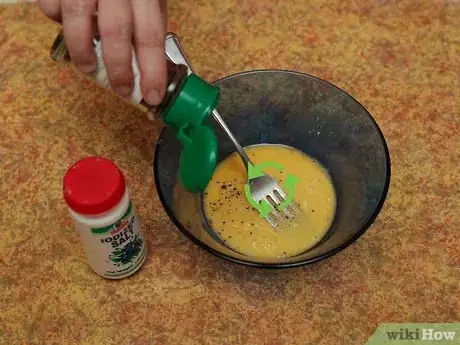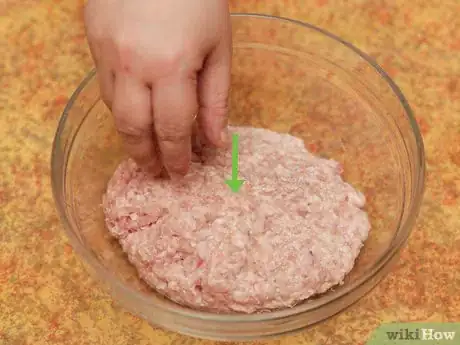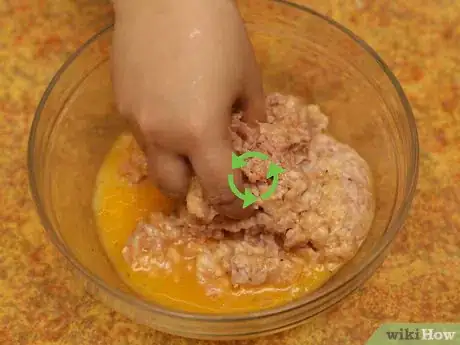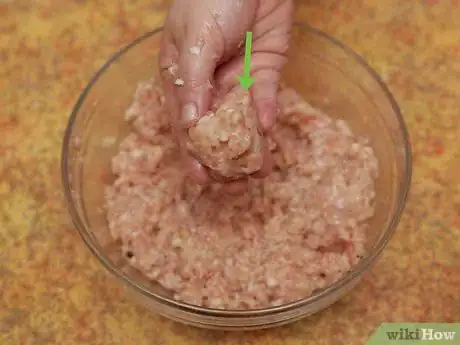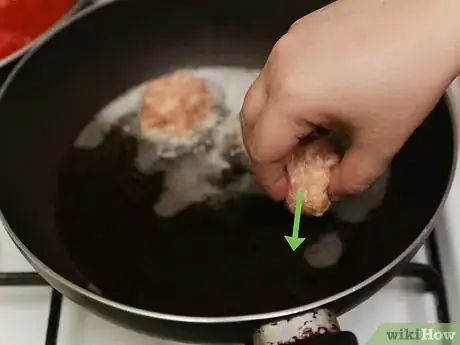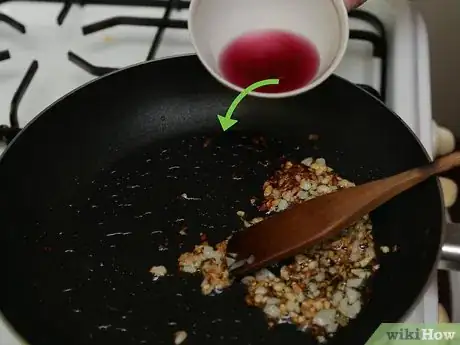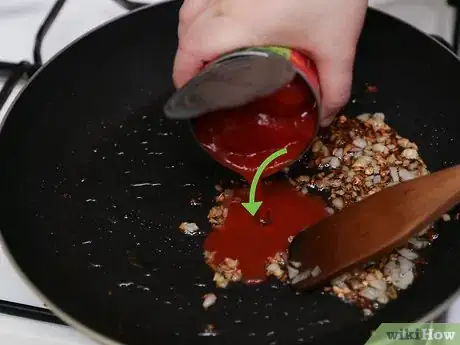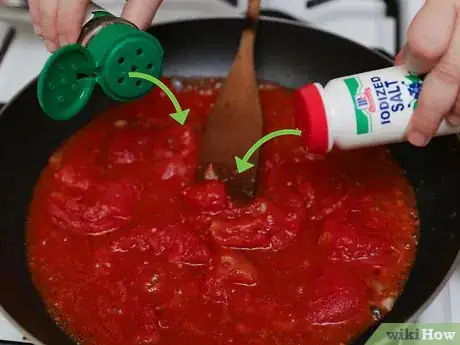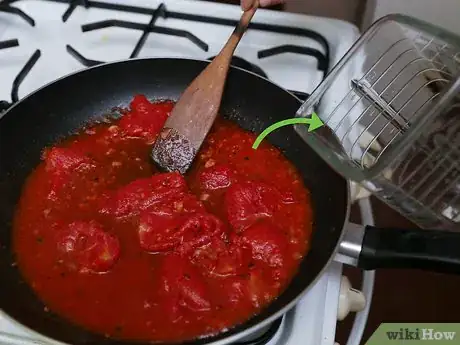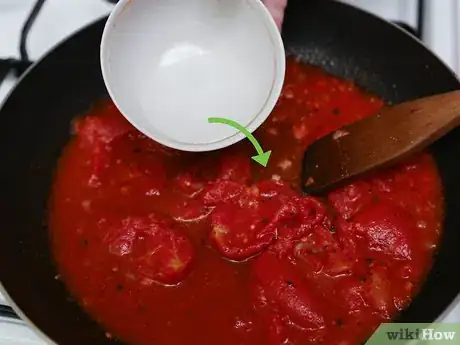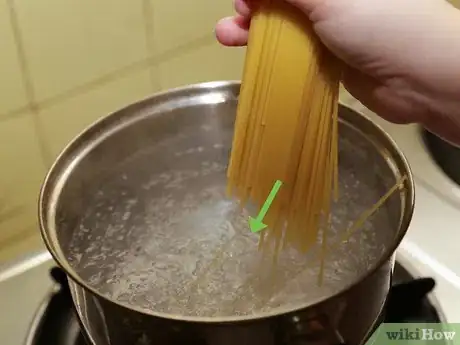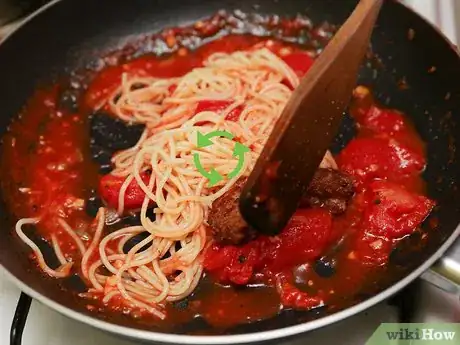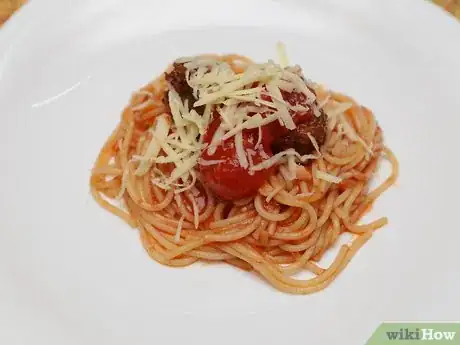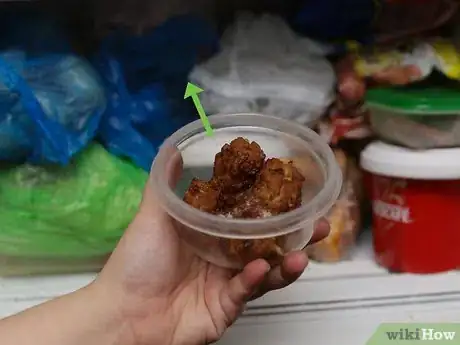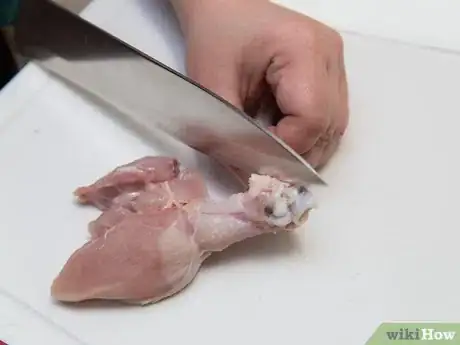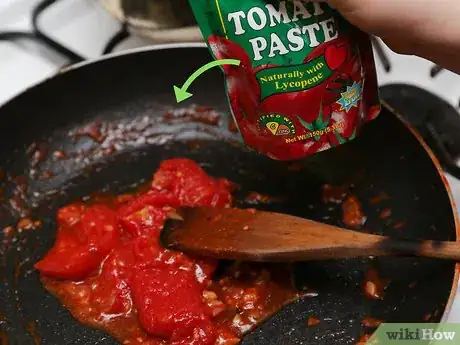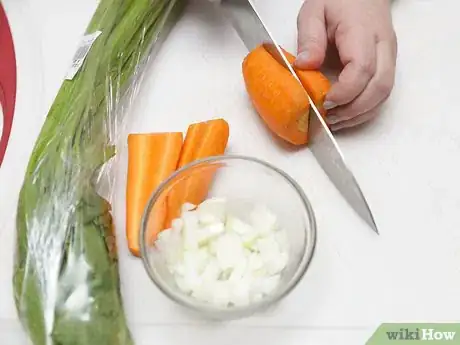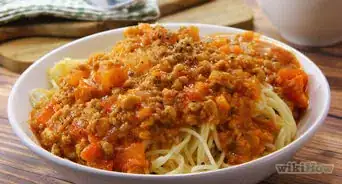This article was co-authored by wikiHow Staff. Our trained team of editors and researchers validate articles for accuracy and comprehensiveness. wikiHow's Content Management Team carefully monitors the work from our editorial staff to ensure that each article is backed by trusted research and meets our high quality standards.
There are 16 references cited in this article, which can be found at the bottom of the page.
This article has been viewed 148,761 times.
Learn more...
The mother of all Italian-American foods, excepting pizza, perhaps, is spaghetti and meatballs. Simple to cook, with easy ingredients and only a little prep work, the dish is somehow marvelously rich and complex. Infinitely tweakable until you find your perfect "family recipe," the basics of spaghetti and meatballs are within any cook's grasp.
Ingredients
This recipe complements 1 pound of spaghetti, and serves 4
Meatballs
- 2 lbs (1 kg) of ground meat -- hamburger, lamb, veal turkey, pork, or a combination.
- 1 egg
- 1 cup (8 oz) bread crumbs
- 1/2 cup (4 oz) grated Parmesan cheese
- Salt & pepper, to taste
- 1 small onion, finely diced (optional)
Tomato Sauce (Jars of sauce can be substituted)
- 1 can 28-ounce plum tomato
- 1 medium white onion
- 2-3 cloves of garlic
- Salt and pepper, to taste
- Olive oil
- 1 cup (8 oz) red wine, optional
- 1 bunch freshly chopped basil, optional
Steps
Making the Meatballs
-
1Whip the eggs in a small bowl with a teaspoon of salt and your choice of seasonings. Use a fork to beat the eggs, as if you were about to scramble them. Then add some salt and get to work seasoning to your heart's content. You can either make up your own seasoning or use one of the following mixes:
- 1 tablespoon (15ml) of your favorite bottle of "Italian" seasoning. Note -- check if it already has salt in it before adding separately.
- 1/2 teaspoon (7ml) oregano, garlic and onion powder, cracked red pepper, rosemary, and/or thyme
- 1 packet powdered onion or mushroom soup mix.
- 1 Adobo chili mixture or spice packet, with salt.[1]
-
2Choose your ground meat and dump it into a big bowl. Classically, meatballs are made from hamburger meat. But mixing things up, like the lovely Italian trio of beef, lamb, and veal, will lead to spectacular meatballs with little extra work.Advertisement
-
3Pour the egg, Parmesan, and bread crumbs in and mix thoroughly with your hands. Plunge your hands in and really squeeze to mix everything up. If you're squeamish, a stiff spatula or wooden spoon will work as well. Just make sure that everything is evenly blended and you have a wet, seasoned pile of meat when done.
- If desired, add the small diced onion here as well. Onion, when cooked, is a savory-sweet complement to the meat.
- Once it looks well mixed, you can stop. Extra mixing isn't helpful, and the more you mix the meat, the tougher it gets.[2]
-
4Roll the meat into 1-inch (2.5 cm) balls. You can make any size you want, but 1" balls tend to brown nicely on the outside while cooking quickly enough on the inside. Grab a small pinch of meat and roll it between your palms to get nice round meatballs.
- If you make larger meatballs, you may need to cook them a little longer, lowering the heat to prevent burning.
- Smaller balls can dry out if cooked too long. They must hit high heat, brown, and then come off quickly before over-cooking..[3]
-
5Fry the meatballs on the stovetop over medium heat until browned on all sides. Use a little bit of oil and rotate the meatballs every few minutes until browned and cooked. If the outsides are done, but the insides are still soft, lower the heat and let them cook for an extra 2-3 minutes. For the best meatballs, let them cook in a 1/2" (1-2 cm) of red sauce after they've browned -- they'll soak up some of the flavor and liquid to stay tender.
- A slow-cooker filled with sauce and meatballs can accomplish the same thing for beautifully rich, slow-cooked meatballs. To make them, add the sauce and meatballs to the cooker and cook on low heat for 6-8 hours.[4]
-
6Alternatively, bake meatballs for 20-30 min at 350F (175C), turning once or twice. Roasted meatballs bring out a rich, crisp flavor and texture, and create far less mess than stovetop cooking. Your biggest worry in the oven is drying out -- be sure to check the smaller balls regularly and take them out as soon as they are cooked all the way through.
- Once they are just about finished, crank the heat to high or put them in the broiler for 1 minute to get a wonderful brown crust on the tops.[5]
Making Homemade Tomato Sauce
-
1Chop an onion and several cloves of garlic. To cut an onion effectively, cut it in half from pole to pole (following the lines of the onion). Place the cut side on the cutting board, then cut the onion horizontally in half, with your knife parallel to the cutting board. From here, simply cut along the "grain," following the lines on the outside of the onion, then cut perpendicular to these cuts to get small onion squares. The garlic can be left whole or finely chopped.
- Whole garlic will have a sharper, slightly spicy flavor. Chopped garlic will take on a slight nutty sweetness as it cooks.
-
2Put a saucepan over medium heat and add 2 tablespoons (30 ml) olive oil. You can also use a tablespoon of butter and one of oil, as well, for a slightly richer sauce.
-
3Add the onions, garlic, and a pinch of salt and stir. Salt brings out moisture immediately to help the ingredients cook perfectly, but it works best if added right with the cold ingredients. Stir well.[6]
- If the garlic is finely chopped, wait a minute to add it. The small pieces will cook, and burn, much faster than the onion will.
-
4Cook until the onion is soft and translucent. Translucent means that the onion is just starting to become see-through. You'll notice the centers becoming slightly clear and the white leaving the onion. This is your sign to move on. It usually takes 3-5 minutes to occur after the onions hit the hot pan.
-
5Deglaze the pan with a cup of red wine, letting it cook until most of the liquid is gone. You can use a bottle of wine from the house or a bottle of cooking wine. If you can't use either, broth or stock works too, and even a splash of cool water is good. Once the liquid hits the pan, use your wooden spoon to scrape up any bits that stuck to the bottom of the pan from the onions so that their flavors meld into your sauce. There should only be a bit of liquid left in the pan before you move on.
- Even if you don't use wine, deglaze the pan quickly before moving on to get these bottom bits. Let the liquid mostly dissolve before proceeding.
-
6Add a can of whole or crushed tomatoes, with juices, and bring to a boil. Add a pinch of salt to the tomatoes and stir them around, using the back of a wooden spoon to smash and smush any whole tomato, releasing more of those juices. Let them heat up until boiling and bubbling.
- If you want to use fresh tomatoes, you must blanch and peel them in advance. Put 7-10 Roma tomatoes in boiling water until the skin loosens (1 minute), then immediately drop them in a bath of ice water. You can then easily pull the skins off, saving the juices and cooking like normal from here out.[7]
-
7Season with salt, pepper, and fresh basil and turn the heat to low. Great cooks know to keep sampling the sauce as it cooks, adding pinches of seasoning here and there to get the perfect sauce. You can also consider a 1/2 cup (4 oz) of vegetable or chicken stock, which will add a nice subtle blend of spices and flavors.[8] Some common spices to add include:
- Handful of fresh basil (note that smaller leaves tend to have the most flavor)
- 1-2 Bay leaves
- Oregano, Rosemary, and/or Thyme
- Ground black or crushed red pepper
- Fresh parsley.[9]
-
8Blend the sauce with a hand mixer, blender, or food processor. If you want the chunky, traditional sauce, leave it as it is. But most people want something with a little smoother consistency and texture, and blending is the best way to go. If you have a stick mixer, this is often the easiest way to do it, as the sauce never has to leave the pan. However, it is just as easy to pour the sauce into your blender or food processor, puree everything, and then pour it back in the pan to keep cooking.
-
9Let the sauce simmer, tasting regularly and adding water if it gets too thick, until serving. The longer a sauce can cook slowly, with only a few heat bubbles breaking the surface, the better it will be. It will thicken as it cooks as well, so keep an eye on it to make sure it stays creamy and liquidy. If it turns too thick, pour in a ladle full of pasta water (if cooking pasta with the dish) and stir. Starchy water will help the sauce bind itself to the pasta when you serve it.[10]
- A splash of water, water with 1 tablespoon tomato paste, or a bit of chicken/vegetable broth can all be used to thin a sauce that is too thick.[11]
- Don't worry if you over-thin out a sauce -- it will thicken again as it heats up.
Assembling the Dish Professionally
-
1Cook your spaghetti according to the instructions on the package. Boil a large pot of water, salting it generously as it heats up to bring out the best taste of the pasta. Many Italian chefs insist that the water should almost taste like the ocean-- almost 4 tablespoons (60 ml). Remove when "al dente:" still firm, but without any crunch.[12]
-
2Save some of the pasta water to thin the sauce. Remember -- starchy pasta water is one of the best ways to thin up a sauce right before serving. Use a ladle to remove some of the starchy water and set aside before draining the water from the pasta.
-
3Throw some of your cooked pasta in a small pan with sauce and meatballs. Restaurants always "finish" the pasta and sauce together instead of simply ladling them into the same bowl. This ensures that everything melds and blends together instead of having a plate of plain spaghetti on top of a puddle of sauce.[13]
-
4Heat the pasta, sauce, and meatballs together for 1-2 minutes, adding a splash of pasta water. Add 1-2 tablespoons of pasta water along with the sauce to thin it out slightly. Furthermore, starchy water helps the sauce stay bound to the pasta instead of polling at the bottom.
-
5Plate and serve immediately with some grated cheese. If the meatballs were roasted separately, you can add one more on top as well for an attractive, centerpiece dish. After marrying the flavors in the pan, serve everything right out of the pan.
Trying Out Variations
-
1Try baking the meatballs directly in the red sauce for a moist, perfectly flavored dish. Once the meatballs are formed, cook them on the stovetop at high heat just until the edges brown. Meanwhile, heat the oven to 400° F (205° C). Dump the half-cooked balls into a shallow baking dish and smother them with your tomato sauce, then cover everything with cheese, such as mozzarella, Romano, or Parmesan. You can then back the whole pan for 15-20 minutes.[14]
- This is also a great way to keep the meatballs hot if you still need to cook spaghetti.
-
2Brown the outside of the meatballs and then freeze them if you need to cook ahead. Don't just freeze the raw meat. Instead, cook the meatballs in a skillet until the outsides are brown, then cool and freeze. When ready to eat them, heat them up for 20 minutes or so in 1/2 of sauce to finish cooking them and thaw them up naturally, leading to almost no loss of texture and flavor.[15]
-
3Use ground turkey or chicken meat for lower-fat meatballs. White meatballs, those made with white meat, aren't typical in spaghetti and meatballs, but that doesn't mean they aren't delicious. Because they have less fat, they are naturally a little less rich, and will have a harder time bonding together. Add an extra 2 tablespoons (4 ml) of bread crumbs to compensate.
- White meatballs, in particular, go well with fresh herbs like rosemary, oregano, and thyme.
-
4Add a can of tomato paste before deglazing the pan for a richer, deeper colored sauce. Tomato paste has a strongly concentrated tomato flavor, which will seep into the onions as they cook. Be sure to deglaze the pan quickly afterwards, thinning the paste and preventing burning.
- If the sauce is a bit too strong due to the paste, add a tablespoon of sugar to balance it out and give the sauce a light sweetness.
-
5Add 1 chopped stalk of celery and one large chopped carrot with the onion for a more nuanced base. Both celery and carrots get sweet when cooked, bringing an earthy richness to the sauce closer to a bolognese than a classic marinara sauce. Add them at the same time as the onion, and make sure they're chopped to about the same size, as well.
- This is a great way to sneak some vegetables into a kid's sauce, as well. Once they are blended up, they will have no idea it is in there.[16]
-
6Try adding some roasted red pepper for new flavor. Simply add the roasted pepper after the onion is almost done cooking up, then blend it up with the rest of the sauce. Roasted peppers are sweet but savory, with a wonderful smokiness that goes well in the sauce. Add some crushed red pepper and cayenne for a spicy arrabbiata sauce, as well.
Community Q&A
-
QuestionWhere can I get meatballs?
 Community AnswerYou can purchase pre-made meatballs or make your own. If you want to make your own, they can be made with minced or ground beef, pork, lamb, etc. I would then refer to wikiHow's article on making meatballs.
Community AnswerYou can purchase pre-made meatballs or make your own. If you want to make your own, they can be made with minced or ground beef, pork, lamb, etc. I would then refer to wikiHow's article on making meatballs. -
QuestionHow long will the sauce simmer for?
 QamarTop AnswererThe sauce will need to simmer for about 10-12 minutes, or until it begins to thicken.
QamarTop AnswererThe sauce will need to simmer for about 10-12 minutes, or until it begins to thicken.
Warnings
- Split open the fattest meatball you have to ensure it is cooked fully. It shouldn't be pink on the inside.⧼thumbs_response⧽
Things You'll Need
- 2 pans (one for spaghetti noodles, one for meat)
- a cookie sheet for meatballs
- large bowl
References
- ↑ http://www.seriouseats.com/recipes/2014/09/super-simple-friday-night-meatballs-recipe.html
- ↑ https://www.thekitchn.com/how-to-make-meatballs-cooking-lessons-from-the-kitchn-108048
- ↑ http://www.realsimple.com/food-recipes/recipe-collections-favorites/popular-ingredients/meatball-recipes
- ↑ http://allrecipes.com/recipe/57981/easy-slow-cooker-meatballs/
- ↑ https://www.thekitchn.com/how-to-make-meatballs-cooking-lessons-from-the-kitchn-108048
- ↑ https://www.thekitchn.com/how-to-cook-onions-correctly-cooking-lessons-from-the-kitchn-185575
- ↑ http://allrecipes.com/recipe/21126/homemade-tomato-sauce-i/
- ↑ http://www.reluctantgourmet.com/basic-tomato-sauce/
- ↑ http://www.foodnetwork.com/recipes/bobby-flay/chicken-parmigiana-recipe.html
- ↑ http://cooking.nytimes.com/recipes/1017169-chicken-parmesan
- ↑ http://www.foodnetwork.com/recipes/food-network-kitchens/chicken-parmesan-recipe2.html
- ↑ http://www.delallo.com/articles/pasta-101-cooking-perfect-pasta-every-time
- ↑ http://www.delallo.com/articles/pasta-101-cooking-perfect-pasta-every-time
- ↑ http://www.realsimple.com/food-recipes/browse-all-recipes/cheesy-baked-meatballs
- ↑ https://www.thekitchn.com/how-to-make-meatballs-cooking-lessons-from-the-kitchn-108048
- ↑ http://www.mommyskitchen.net/2012/02/sneaky-spaghetti-sauce.html
About This Article
To make spaghetti and meatballs, start by making the meatballs out of the ground meat of your choice, 1 egg, bread crumbs, Parmesan cheese, and salt and pepper. Use your hands to thoroughly combine the ingredients together in a bowl before shaping the mixture into small, 1-inch balls by rolling them between your palms. Next, if you aren't using a jar of pasta sauce, make your own by simmering canned tomatoes, white onion, garlic cloves, olive oil, and salt and pepper on the stove. For more advice on cooking spaghetti with meatballs, including how to put the whole dish together, keep reading!
